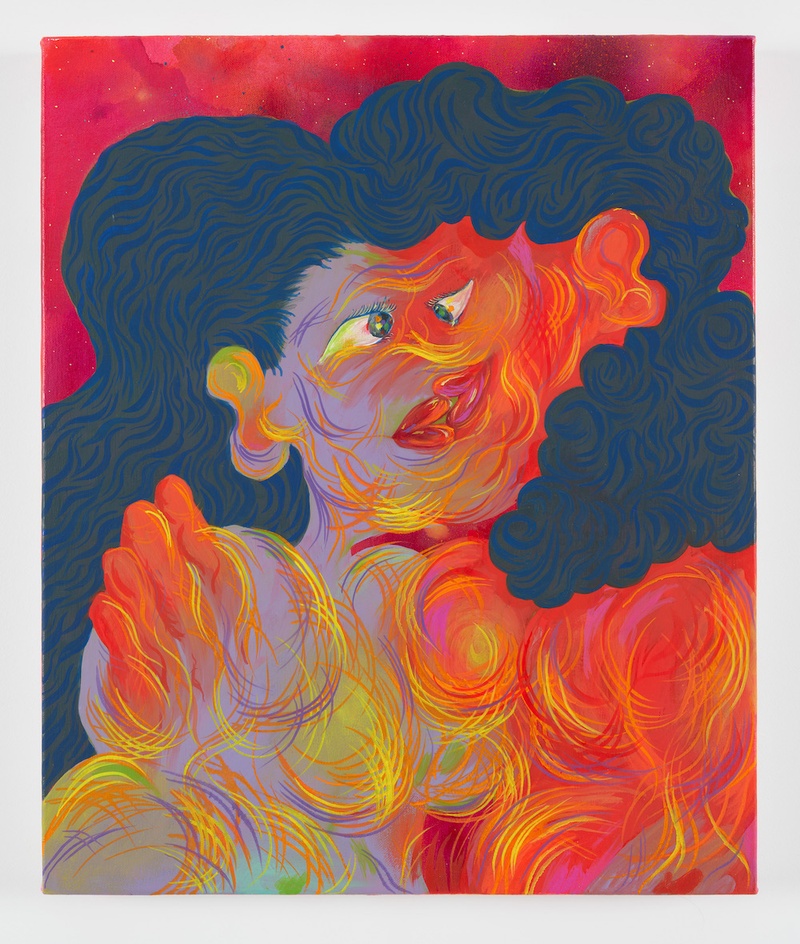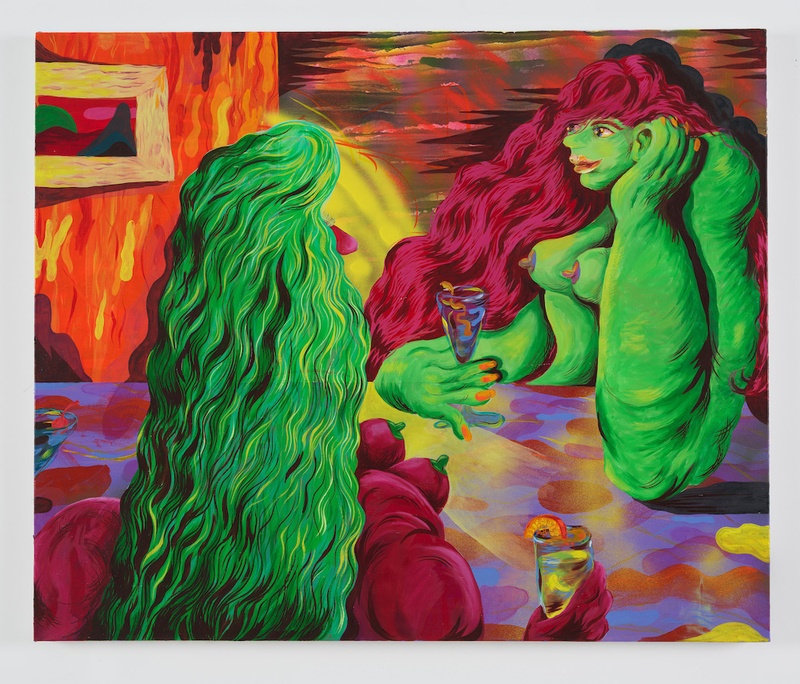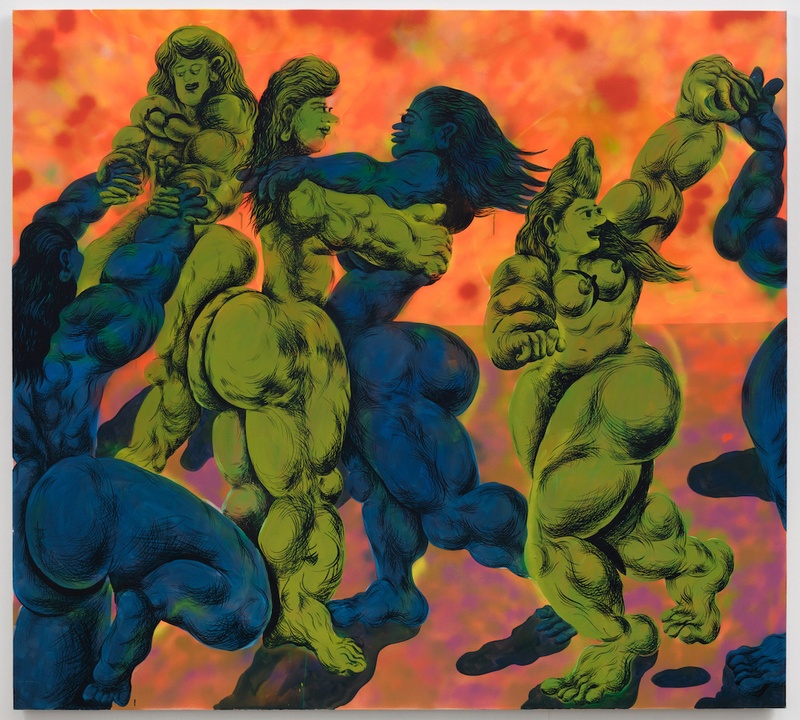You began your career as a commercial artist, doing illustration and graphic design, and later decided to focus on painting and fine art. Was it a big shift from working professionally as an illustrator to as a painter?
Yes and no. No in how I viewed myself. I always viewed myself as an artist. And I was always interested in the body and a lot of similar themes, even though, as an illustrator, [I didn’t] always directly deal with it. I just graduated with my Master’s a little over a year ago, and so I’m just starting my career as a fine artist, quote unquote. So it’s something I’m still sorting out, like, “How do I view myself differently? Do I see myself differently? What kind of fine art do I want to make? Do I want to just make paintings? Do I want to make posters, little sculptures, editions of things? What do I want to bring with me from my background as an illustrator into my work as an artist?” That’s something I’m really interested in. And also just at the beginning stages of sorting that in my head.
Do you feel like there is pressure to think of yourself differently in that shift to fine art?
I think so. I think the art world is definitely still super elitist in how it views itself and how it views the proper applications or things that an artist should do with their work. It’s something I’m thinking about a lot, how I am perceived, even though it’s something I don’t want to think about, honestly. I just want to make work and be taken seriously.
What has you thinking more about how you’re perceived as an artist?
I guess just my experience working all those years as an illustrator, and having interest in showing in galleries or having my work accepted outside the realm of commercial illustration, and being completely dismissed. Granted, I also maybe didn’t have the education background to understand how to navigate the fine art world. But, I think I still carry some of that with me, the understanding that certain things are viewed as art and certain things are not viewed as art. There’s definitely a hierarchy that still exists.
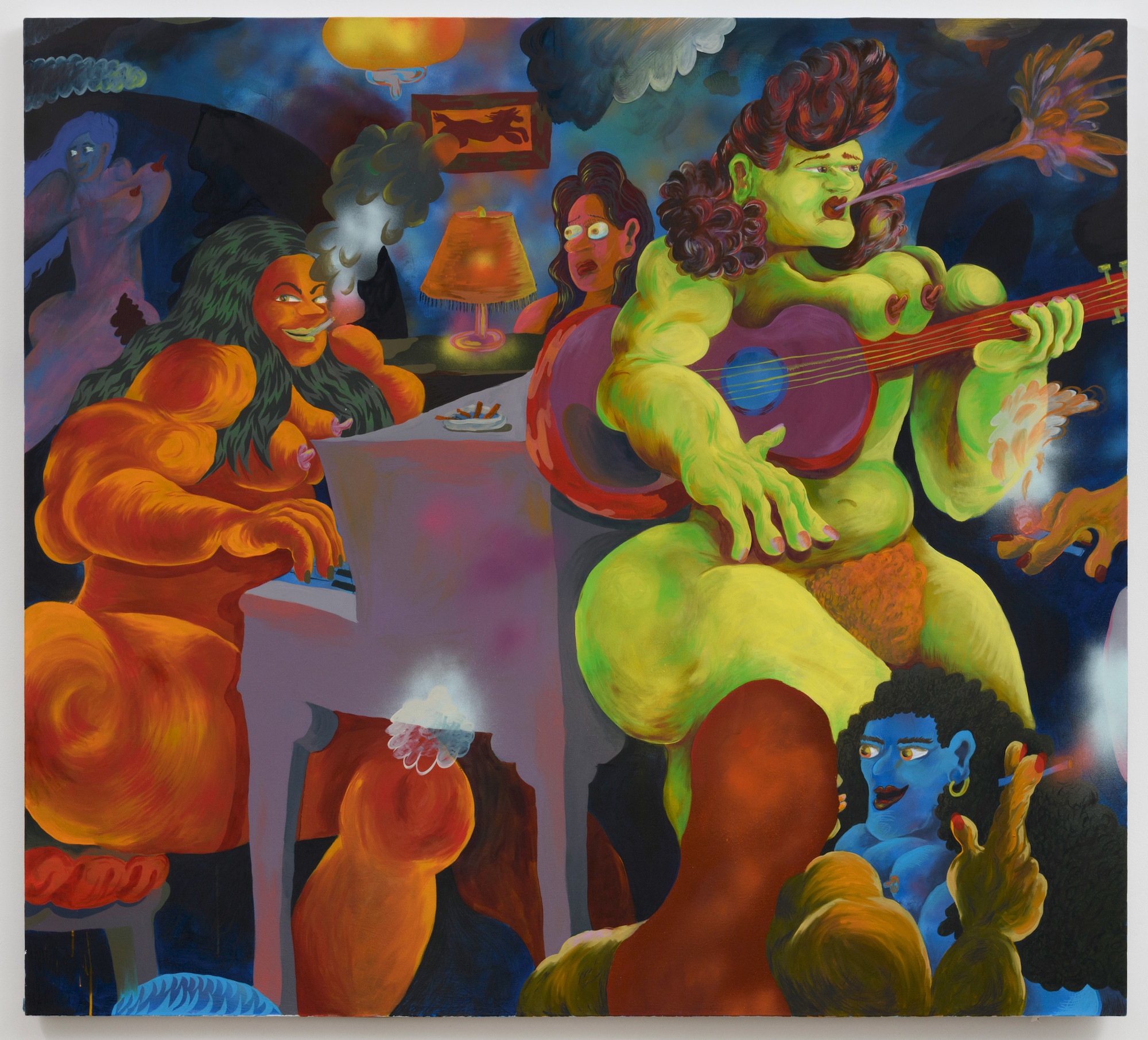 Ana Benaroya, Hot House
Ana Benaroya, Hot House
Coming from your career as an illustrator and shifting into fine art, how do you navigate what success looks like for you?
Honestly, it’s being able to make the work I want to make and having people be interested in it. And when I say people, I mean everyday people like you and me. People who maybe don’t even consider themselves as artists, but have an interest in it. I also would ideally love to be accepted on the institutional level—have work shown in museums and galleries. I’m really interested in somehow bridging the gap between those two worlds. And I think artists are paying more and more attention to that, but that’s something that’s really important to me and how I would want success to look like for me.
How has your approach to art changed since going to grad school?
This might sound very simplistic, but, going to grad school, my main goal was to just get better at painting. Obviously, I painted leading up to school and applied to school with painting, but I never had dedicated time to just, quote unquote, improve my craft. But also, I think I didn’t know what I was getting myself into. I studied illustration in undergrad, [but] I didn’t really have the background in critical theory that a lot of my [grad school] classmates did. I had some arts historical background, but not to the same extent as some of my classmates. It was more of me playing catch up and trying to figure out how I could relate the work I was doing to contemporary conversations, but I didn’t have the language to understand how to place it. A lot of grad school was just finding new language and also finding my voice in painting, which I’m still finding. The other thing is, as an illustrator, you always have a client and usually you’re always responding to a brief of some sort. As an artist, you are the brief. Your brain is the brief. Whatever your thoughts are is the reason to make what you’re making. Or at least that’s how I view it. [Grad school] was just a reframing of what I was doing already, and hopefully slowly improving and getting better at what I was doing.
Ana Benaroya, Flight of the Raven
What does your workspace look like? What is essential for you to be able to do your work?
My studio is relatively small, so it’s currently extremely crowded and packed with paintings. I like to have my studio be somewhat homey, so I have carpets on the floors. I have little decorative things all over and posters and stuff, my old sketchbooks. I have a window in my studio. I do need a window. I need some natural light.
To make my work, I usually start with just a sketchbook and pencil, and I make sketches. Sometimes I don’t even do that. Sometimes I just start painting. Usually, I start with acrylic and spray paint [and] create an abstract background that I then cover in different layers and eventually build up my image. I like starting from not a white beginning. And I do have some planning, but I like to allow for unexpected things to happen while I paint. No matter how much I try to plan everything, it just never goes that way. A lot of it’s intuitive. Color I usually figure out as I go along.
What does editing look like for you since you work so intuitively?
I don’t like editing very much. I can be quite stubborn actually. I do listen to my friends’ advice and critiques sometimes, but I can also be really stubborn and not listen to anything. Unless it almost looks bad to me, I tend to just keep moving forward and take whatever lessons I learned into the next painting or the next drawing. If I restart something, usually it’s a complete destruction of what I have, like I cover something up completely. I rarely nitpick and go back and change little details.
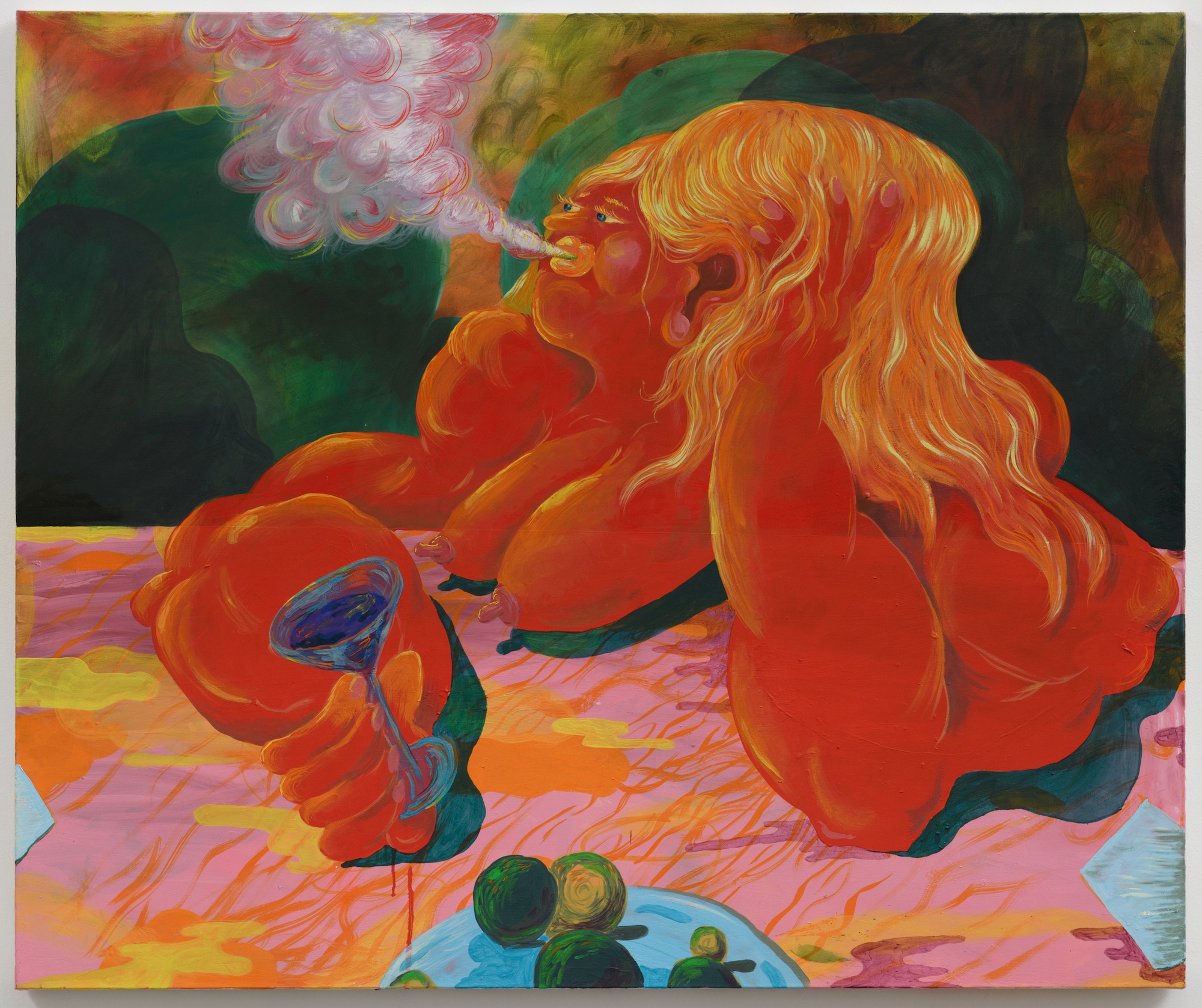 Ana Benaroya, You’re Clear Out of this World When I’m Looking At You
Ana Benaroya, You’re Clear Out of this World When I’m Looking At You
Is it hard for you to completely destroy or give up on a piece when you realize that it’s not working?
No. Usually it’s a buildup of me trying to make it work, getting increasingly frustrated and then just an explosion of frustration. Then I just destroy it. It doesn’t happen that often. I recently have been trying to at least give myself one day to sleep on it and come back the next day to see it clearly, hopefully. But that doesn’t always happen.
When you have a concept for something, how does exploring that for your own work compare to exploring an idea for a client when you were an illustrator?
Recently, I’ve been organizing my shows around a particular place. [The paintings for] my show in L.A. took place in this imaginary cafe where these women came and played music and drank and smoke. And [the work for] my upcoming show in November takes place in an apartment—kind of a Gertrude Stein-style apartment—where these women are coming together and discussing art and culture. They’re sculpting, they’re painting, reading, writing, but it all happens in one location. I think that narrative tool that I’m using is a leftover from my years as an illustrator. I’ve realized that I like having some sort of narrative structure to my work and what it does. It’s not a literal prompt or a brief, like I was talking about before, but it allows me to organize my thoughts for a show. When I’m making a body of work for a show, I’m creating the brief with each painting. I’m adding to it little by little, I’m discovering it as I go along, whereas when I was doing a commission, that was provided for me.
With the series of women at the cafe, can you walk me a little bit through the first inspiration for that and what your curiosity around that looked like? What did you do to explore it?
It was inspired actually by Casablanca, by Rick’s Cafe. I watched that movie at the recommendation of a friend, and I guess I liked the idea of this cafe where there are these underground—not criminal, but secret—activities that were not apparent to the viewer or to the patrons immediately. At the time, I rediscovered my love of painting music, painting pianos specifically. That got me into the idea of painting these women playing music. It was this place where female desire, lesbian desire, was in the air. Maybe in some paintings, it was more explicit, but not in every single one. The idea was that it was this secret place where they could be themselves. When I made one painting, I could imagine turning my head in that space looking in the other corner of the room, and I would see my other painting. Or I would get the idea for my next painting. That’s how it evolved. I think I’m doing the same thing for this next show, which is an apartment, so there’s many rooms. I like the idea of walking through this apartment as a partygoer and opening the door to a new room and seeing this whole other scene or this whole other world that I then translate into a painting in some way.
Ana Benaroya, Feel the World and Melt Upon It
Ana Benaroya, Almost Like Being In Love
What about human bodies keeps you coming back to exploring them and having them be a focus in your work?
I’ve always been obsessed with the human body and learning how to draw it since I was a little kid, starting with learning how to draw all the muscles. Just as a human myself, human interaction, intimacy, desire for love, desire for sex, violence, all these things, they are what occupy my mind. And I try to figure all these things out through my paintings, through depicting the figure. These figures are all in some strange way an extension of myself. Obviously, it’s not all autobiographical. It’s very fantastical, but these are little bits of me that come out. I’m allowed to, for a moment, live out these different bodies in my paintings. I can escape my body just for a little bit.
In doing your work, have you found that there are any habits or inclinations that you’ve developed that you try to check yourself on?
It’s a fine line [between] repeating yourself and getting complacent, but also acknowledging certain things that make you as an artist. My tendency is to move on quickly, to try and not repeat myself. But the danger with that is then you don’t slow down enough to get more complex within an idea or within a body of work. For example, I love painting pianos. Will there come a day when I think, “Okay, I’ve repeated this way too much. I shouldn’t do this anymore?” I don’t know. I don’t think that’s happened to me yet because I’m still early in my career. But if you think about that, some artists literally do the same thing over and over again, but it’s still interesting. Other artists do that and it’s extremely boring. How do you keep it interesting? I don’t know. That’s something that I do think about.
How do you avoid burnout?
I did get really burned out in my mid-twenties, and it took me a while to get excited again about what I was doing. I’ve been really careful to not reach that point again. I tend to be a workaholic. This is something I’m aware of. It’s one of my issues. For a while before the pandemic—the pandemic kind of messed all this up—I really tried to keep my weekends for myself [and] organize my week as a nine-to-five-ish schedule, even though I’m working for myself, and make plans in the evening with friends or something. That truly helps me. I just can’t paint all day into the night. Obviously now life is a little different, but I haven’t felt that same level of burnout since.
What advice do you have for people who want to do what you do?
Work hard. I know I just talked about not burning out, but really push yourself. Really challenge yourself. Don’t be complacent. Look to other artists, talk to them. Try not to view other artists as competition, view them as your peers and as people who are with you on this journey.
And [have] some level of stubbornness and belief in yourself. You want to be open-minded and listen to people’s advice and opinions, but you have to remember what excites you as an artist and what’s important to you as an artist and not lose that and stay true to yourself. I know those are all somewhat generic phrases, but I think they’re actually really true. Just keep making work. It’s easy to get distracted by the art world, social media, gossip, even being social in regular times. Really what it comes down to is making work and continuing to make work and not giving up. Just keep being there and eventually hope that someone notices. And I think if you keep doing it, somebody will.
I’m interested in what you said about seeing other artists as peers, teammates, and resources. Is that something you had to learn or is that something that came naturally to you?
I had to learn it. I don’t think it came naturally. My main source of knowledge throughout grad school, and even before grad school, was from other artists. I would even venture to say I learned more from my peers than from a lot of my teachers, even beyond just art knowledge. Career knowledge, I’ve also mostly learned from my peers through the mistakes they’ve made and mistakes I make that I share with them. In the end, it’s not a fun life to view everybody as competition. It’s quite toxic. And I think it ends up affecting your work in a really negative way. It’s just much more fun to celebrate your friends’ accomplishments than it is to… Even though it can be hard sometimes. I’m not saying it’s always easy. It’s just… What a fun life, if you can celebrate, not only your accomplishments, but the accomplishments of your peers, and hopefully you all rise together. That’s the dream. The goal is to be there together at the end.
Ana Benaroya Recommends:
-
Wawa—definitely try their coffee, specifically French Vanilla coffee with their brand of French Vanilla creamer. Also, they make the best hoagies on this planet. I love the touchscreens where you order, how you can select each topping and condiment that you want.
-
Celine Dion—she is a goddess, I worship the ground that she walks on.
-
Salt and Vinegar potato chips—they are my favorite type of potato chip.
-
Mismatching your socks—it’s fun.
-
The Bachelor / Bachelorette franchise - yes, I am part of #bachelornation
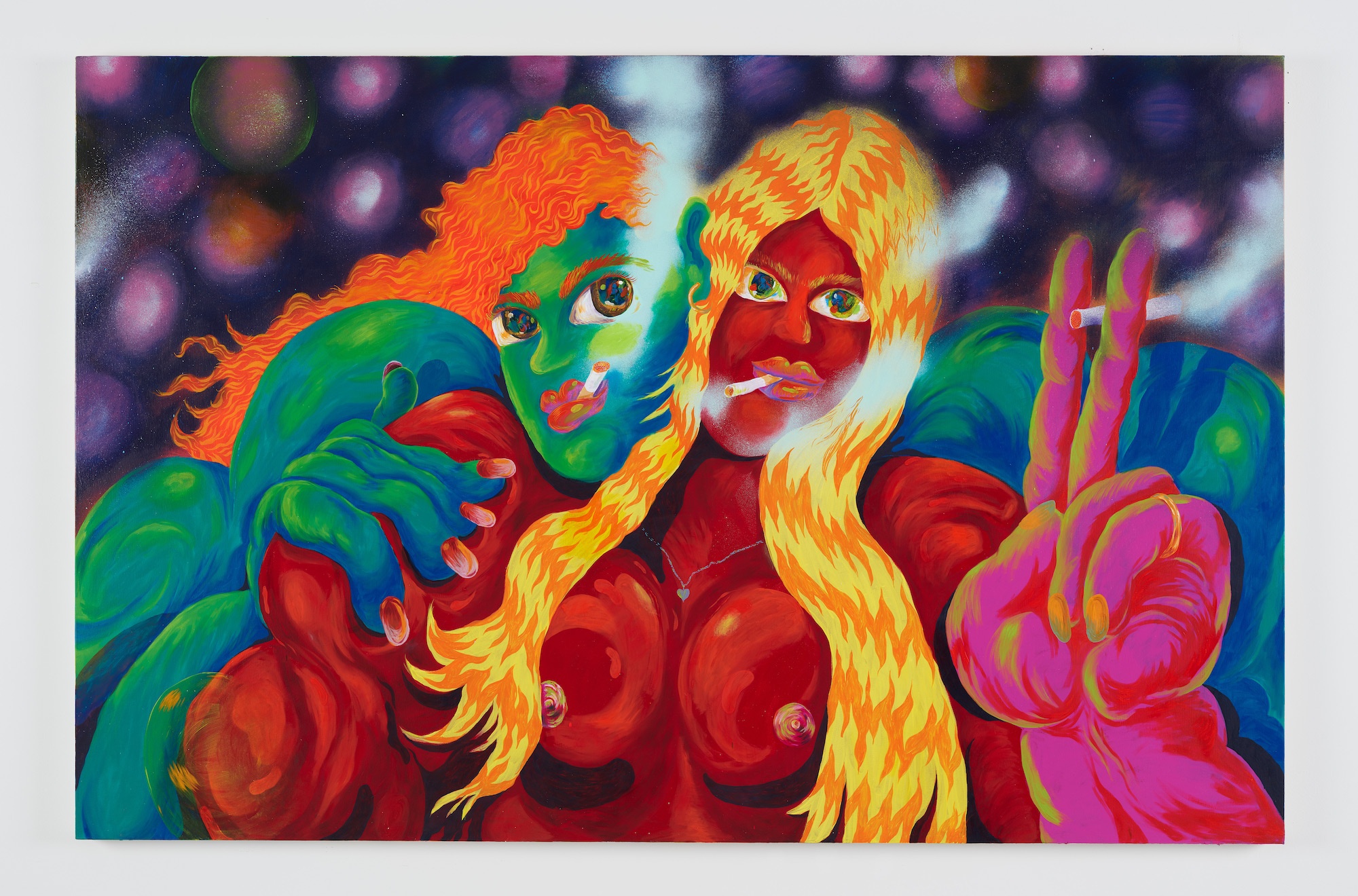 Ana Benaroya, I Feel Love I Feel Love
Ana Benaroya, I Feel Love I Feel Love
This content originally appeared on The Creative Independent and was authored by Ann-Derrick Gaillot.
Ann-Derrick Gaillot | Radio Free (2023-01-27T08:00:00+00:00) Visual artist Ana Benaroya on allowing for the unexpected. Retrieved from https://www.radiofree.org/2023/01/27/visual-artist-ana-benaroya-on-allowing-for-the-unexpected/
Please log in to upload a file.
There are no updates yet.
Click the Upload button above to add an update.
